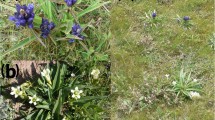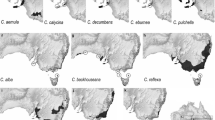Abstract
Phylogenetic analysis of chloroplast DNA (cpDNA) restriction site variation supports a close genetic relationship between the Southwest AsianSenecio flavus subsp.breviflorus and the North AmericanS. mohavensis. The intercontinental disjunct distribution of these two desert annuals may have originated via long distance dispersal. The chloroplast genomes of the Southern and North AfricanS. flavus subsp.flavus and subsp.breviflorus differ by at least ten restriction sites, while at most two restriction sites differentiate the cpDNA genomes of subsp.breviflorus and the outgroupS. squalidus. This suggests that the cpDNA genome ofS. flavus subsp.breviflorus may have resulted from introgression and chloroplast capture with a Mediterranean species related toS. squalidus. This hypothesized introgression could account for the morphological distinctiveness and duplicated isozyme loci ofS. flavus subsp.breviflorus relative to subsp.flavus.
Similar content being viewed by others
References
Abbott, R. J., Ashton, P. A., Forbes, D. J., 1992: Introgressive origin of the radiate groundsel,Senecio vulgaris L. var.hibernicus Syme:Aat-3 evidence. — Heredity68: 425–435.
Abbott, R. J., Curnow, D. J., Irwin, J. A., 1995: Molecular systematics ofSenecio squalidus L. and its close diploid relatives. — InHind, D. J. N., Jeffrey, C., Pope, G. V., (Eds): Advances inCompositae systematics, pp. 223–237. — Kew: Royal Botanic Gardens.
Alexander, J. C. M., 1975: Experimental taxonomy in some annual species ofSenecio from the Mediterranean area. — Ph.D. Thesis, University of Edinburgh, Scotland.
, 1979: Mediterranean species ofSenecio sectionSenecio andDelphinifolius. — Notes Roy. Bot. Gard. Edinburgh37: 387–428.
Avise, J. C., 1994: Molecular markers, natural history and evolution. — New York: Chapman & Hall.
Barkley, T. M., 1993:Senecio. — InHickman, J. C., (Ed.): The Jepson manual, pp. 336–342. — Berkeley: University of California.
Danin, A., Shmida, A., Liston, A., 1985: Contribution to the flora of Sinai, III. Checklist of species collected and recorded by the Jerusalem team 1967–1982. — Willdenowia15: 255–322.
Doyle, J. J., Doyle, J. L., 1987: A rapid DNA isolation procedure for small quantities of fresh leaf tissue. — Phytochem. Bull19: 11–15.
Gray, A., 1886: Synopsis of the flora of North America,1, 2nd edn. — Washington, D.C.: Smithsonian Institution.
Harris, S. A., Ingram, R., 1992a: Molecular systematics of the genusSenecio L. I: Hybridization in a British polyploid complex. — Heredity69: 1–10.
, 1992b: Molecular systematics of the genusSenecio L. II: the origin ofS. vulgaris L. — Heredity69: 112–121.
Hickman, J. C., 1993: The Jepson manual. — Berkeley: University of California.
Ingram, R., Weir, J., Abbott, R. J., 1980: New evidence concerning the origin of inland radiate groundsel,Senecio vulgaris var.hibernicus Syme. — New Phytologist84: 543–546.
Jeffrey, C., 1979: Generic and sectional limits inSenecio (Compositae) II. Evaluation of some recent studies. — Kew Bull.34: 49–58.
, 1977: Generic and sectional limits inSenecio (Compositae) I. Progress report. — Kew Bull.32: 47–67.
Kadereit, J. W., 1983: experimental study and revision ofSenecio sect.Obaejacae DC. — Ph.D. Thesis, University of Cambridge, U.K.
, 1984: Some notes on annual species ofSenecio L. (Asteraceae) from northern Africa and the Canary Islands. — Bot. Jahrb. Syst.104: 509–517.
Liston, A., 1992: Variation in the chloroplast genesrpoC1 andrpoC2 of the genusAstragalus (Fabaceae): evidence from restriction site mapping of a PCR-amplified fragment. — Amer. J. Bot.79: 953–961.
, 1989: Genetic similarity is high between intercontinental disjunct species ofSenecio. — Amer. J. Bot.76: 383–388.
McLaughlin, S. P., Bowers, J. E., Hall, K. R. F., 1988: Vascular plants of Eastern Imperial County. — Madroño34: 359–378.
Neuhaus, H., Link, G., 1987: The chloroplast tRNA-Lys (UUU) gene from mustard (Sinapis alba) contains a class II intron potentially coding for a maturase-related polypeptide. — Curr. Genet.11: 251–257.
Ornduff, R., Raven, P. H., Kyhos, D. W., Kruckeberg, A. R., 1963: Chromosome numbers inCompositae. III.Senecioneae. — Amer. J. Bot.50: 131–139.
Rieseberg, L. H., Brunsfeld, S. J., 1992: Molecular evidence and plant introgression. — InSoltis, P. S., Soltis, D. E., Doyle, J. J., (Eds): Molecular systematics of plants, pp. 151–176. — New York: Chapman & Hall.
, 1991: Phylogenetic consequences of cytoplasmic gene flow in plants. — Evol. Trends Pl.5: 65–84.
Shinozaki, K., Ohme, M., Tanaka, M., Wakasugi, T., Hayashida, N., Matsubayashi, T., Zaita, N., Chunwongse, J., Obokata, J., Yamaguchi-Shinozaki, K., Ohto, C., Torazawa, K., Meng, B.-Y., Sugita, M., Deno, H., Kamagoshira, T., Yamada, K., Kusuda, J., Takaiwa, F., Kato, A., Tohdoh, N., Shimada, H., Sugiura, M., 1986: The complete nucleotide sequence of the tobacco chloroplast genome: its organization and expression. — EMBO J.5: 2043–2049.
Shmida, A., 1985: Biogeography of the desert flora. — InEvenari, M., Noy-Meir, I., (Eds): Hot deserts and arid shrublands, pp. 33–77. — Amsterdam: Elsevier.
Smith, J. F., Sytsma, K. J., Shoemaker, J. S., Smith, R. L., 1991: A qualitative comparison of total cellular DNA extraction protocols. — Phytochem. Bull.23: 2–9.
Swofford, D. L., 1991: PAUP: Phylogenetic analysis using parsimony, Version 3.0. Computer program distributed by the Illinois Natural History Survey. — Champaign, Illinois.
Sytsma, K. J., Schaal, B. A., 1985: Phylogenetics of theLisianthus skinneri (Gentianaceae) species complex in Panama utilizing DNA restriction fragment analysis. — Evolution39: 594–608.
Taberlet, P., Gielly, L., Pautou, G., Bouvet, J., 1991: Universal primers for amplification of three non-coding regions of chloroplast DNA. — Pl. Molec. Biol. Reporter17: 1105–1109.
Thorne, R. F., 1986: A historical sketch of the vegetation of the Mojave and Colorado deserts of the American southwest. — Ann. Missouri Bot. Gard.73: 642–651.
Van Zinderen Bakker, E. M., 1975: The origin and paleoenvironment of the Namib desert biome. — J. Biogeography2: 65–73.
Werger, M. J. A., 1978: The Karoo-Namib region. — InWerger, M. J. A., (Ed.): Biogeography and ecology of southern Africa, pp. 233–299. — The Hague: Junk.
Wickens, G. E., 1984: Flora. — InCloudsley-Thompson, J. L., (Ed.): Key environments: Saharan Desert, pp. 67–75. — London: Pergamon.
Zohary, M., 1973: Geobotanical foundations of the Middle East.,1 — Stuttgart: G. Fischer.
Author information
Authors and Affiliations
Rights and permissions
About this article
Cite this article
Liston, A., Kadereit, J.W. Chloroplast DNA evidence for introgression and long distance dispersal in the desert annualSenecio flavus (Asteraceae). Pl Syst Evol 197, 33–41 (1995). https://doi.org/10.1007/BF00984630
Received:
Revised:
Accepted:
Issue Date:
DOI: https://doi.org/10.1007/BF00984630




